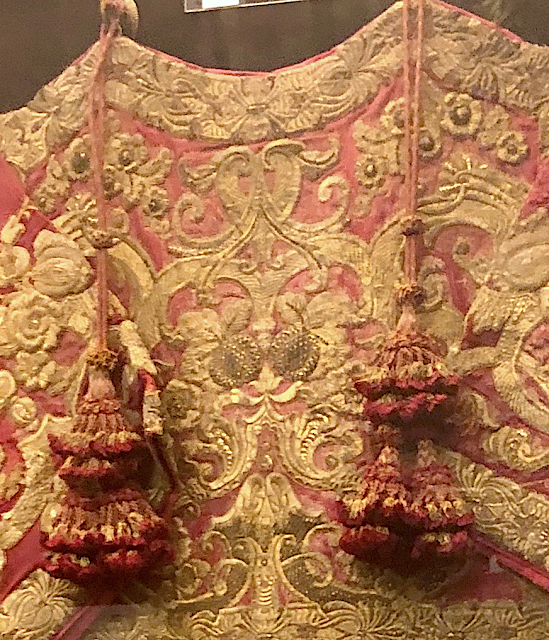
The topic of tassels on dalmatics and tunicles is one of those subjects that arises from time to time often accompanied by questions such as, "What is their purpose? How are they to be worn?" From any research I've done on this subject, very little is documented about this matter but what does seem reasonably clear is that, historically, ties, cords and the like -- in both civil and ecclesiastical dress -- came to be ornamented with fringes and tassels through the usual -- what we might call -- ornamental imperative that tends to accompany most any dress, but particularly ceremonial dress. In the case of the dalmatic and tunic, when these specific ornaments came about is unclear, but what can be said is that fringes, at the very least, can be observed in representations of them as early as the 7th century.
In terms of their purpose, they seem clearly ornamental, however there is a connection to the practical it would seem; namely, the dalmatic and tunic at some point came to have ties at the shoulder/neck which would allow the vestment to be put on more easily and then secured with ties. Here are a couple of contemporary examples showing these ties:
It is often surmised that these ties therefore came to be ornamented at their ends with tassels, much like the ends of the cincture. (We see similar ornaments accompany the Spanish 'collarin' as well -- an ornamental collar that traces its origins from the apparel on the amice.) As with other elements of ecclesiastical vesture, this practical origin wasn't strictly maintained and in some instances they came to be purely and entirely decorative.
If this is the possible origins of such tassels, this may also help to answer the related question of how they should be worn -- namely, on the front or on the back? Within historical depictions one can see them worn either on the front or on the back -- or both. Here are some 15th and early 16th century depictions of St. Stephen, for example, that show them on the front:
In other depictions we see them placed on the back, as seen in these illustrations from 17th/18th century editions of the Pontificale Romanum and Caeremoniale Episcoporum:
Or this painting which I believe comes from around the time of Pope Sixtus IV
What's more, as already mentioned, one also sees them worn on both the front and back as shown in this illumination of the Missa Coram Summo Pontiice in the Sistine Chapel during the papacy of Pope Sixtus IV:
The form of wearing the tassels on the back does, in point of fact, seem to be the most common use in the past few centuries however -- which makes manifest sense given their (eventual) ornamental nature (as the back side of the vestments would be the most visible liturgically) and given that there would also seem to be some practical advantages in their placement solely on the back as it would make them less likely to encumber the liturgical ceremonies.
In terms of the form of the tassels, various examples can be found, from a single tassel per cord, or even two, three or four:
 |
| One can see here how these tassels have become purely ornamental in this example. |
Here is another common variant which shows three tassels in total:
In terms of the stylistic form of these tassels, while many of the examples shown here come in the form of a traditional tassel as many think of it today, some later examples shown slightly more ornamental forms that are quite appealing and particularly worthy of imitation by contemporary vestment designers in my estimation:
In offering these brief considerations, I make no pretence that this represents a truly scientific study of the matter. Rather, it is simply my hope that these considerations may provide some sense of the possible origins of this vestural element and may also provide some sense of the historical variations that have been found throughout the past millemniun.























